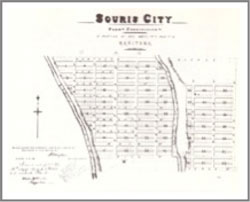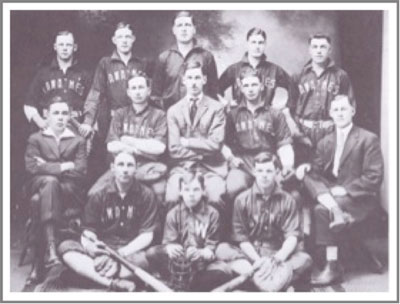THE THOUSANDS OF PEOPLE
who have
made Wawanesa their home over the years, since its inception in 1890,
have been a fascinating group, full of strength and wisdom, wit and
vigour, kindness and foresight.
Some of these people are also significant, key figures in our history.
They have either come to define the region by their very being, or they
have changed our communities through their actions and decisions.
This booklet recognizes and honours these people.
On the following pages you will encounter the collection of people who
have made a real difference. The way we have chosen to explore and
describe these people has been to focus on traditional occupations and
avocations. With one key person typically defining each entry (a
merchant, a school teacher, a brick-maker, etc.) we expect that the
rich and deep experience of life and work in Wawanesa can be
effectively and succinctly defined.
The people profiled in this booklet are special, but we have also
endeavoured to feature others with slightly lesser claims to
significance, who help define or enhance a certain entry. And where
possible we have also added information and details on certain
occupations and avocations so that readers can come to fully understand
and appreciate who these people were, what they did, and how they did
it.
This booklet was developed through a project called Notable People, an
initiative of the Historic Resources Branch of Manitoba Culture,
Heritage and Tourism. That project allowed us to develop a
comprehensive inventory of potential candidates, and to carefully
analyze and assess the relative significance of the 140 individuals
profiled. We are grateful to the Province for this support and
direction.
It is easy at the turn of the 21st century to forget the origins and
qualities of Manitoba’s smaller communities. But at their beginnings
these were very industrious places, with young, ambitious people, full
of life, and with great dreams for their new home. It is also important
to recall that these places were also self-sustaining, with nearly
everything one would need made at hand. Much of what was required for
daily life was manufactured here, from bricks to dresses, harnesses to
flour. Places like Wawanesa in 1900 were active, lively and fun.
It is important to set the stage for the following stories. They come
from the excellent local history, “Sipiweske” produced by the Wawanesa
History Committee in 1983, with additional material from “Oakland
Echoes”, by J. B. Rome and “The Prairie W.A.S.P.”, by J.A.D. Stuart
Historical Overview
Wawanesa is one of numerous Manitoba towns that had its original
location abandoned when a nearby site was chosen by a railway company.
In this case the village of Souris City, originally surveyed in 1881,
had only a short way to travel. It is also one of dozens of towns that
sprang up almost overnight when a railway station appeared in the
middle of a well-populated farmland.
As the first settlers in the Wawanesa area established themselves in
the years 1879-1884 two important communities developed within a few
kilometres of the current site of Wawanesa. Millford, established in
1880 at the mouth of Oak Creek, close to the confluence of the Souris
and Assiniboine Rivers was the first village south of the Assiniboine
in western Manitoba. It was soon joined by Souris City on 17-7-17 just
south of Wawanesa.
During a time when dozens of speculative town sites were promoted
during the Manitoba Boom of 1881-82, these two locations had the
distinction of at least being inhabited and each indeed did have a
selection of services for pioneers. Many other such “Great Cities
of the Future” existed on paper only. To the north, Rounthwaite also
was well established by 1882 and boasted the first Anglican Church in
southwestern Manitoba, an attractive building which is now located at
the Sipiweski Museum in Wawanesa after many decades of service.

The Souris City Plan was registered in 1881
Settlers turned to these embryo villages for mail and supplies. Trips
to Brandon, a day’s journey north, were necessary for selling grain and
buying the more specialized items. A thriving grist mill operated along
the river to the south by the John Gregory family and a brick yard near
Souris City also were well used by the settlers.
With such services in place the settlers turned their attention to the
business of establishing farms while the railway companies just kept
making promises. By the time the current town of Wawanesa appeared in
1890, the region itself had a long and interesting history.
In the winter of 1889/1990 most of the residents of Souris City used
the river ice to slide their dwellings and business structures a few
kilometres northwards to the newly created railway crossing at
Wawanesa. In a few short months the little village nestled attractively
in a deep wide bend of the Souris River sprang fully-fledged into being.
It was predictable that Wawanesa would grow quickly and confidently in
that the vital rail link placed it at the centre of an already
well-established agricultural base. There was no speculation or
uncertainty about its importance as a service centre, however its role
as a home to a large international insurance company could not have
been predicted. The formation of the Wawanesa Mutual Insurance Company
initially impacted only locals but it grew into an international
company that provided a very significant addition to the economic life
of the village.

The humble beginnings of the “The Mutual”
The much-anticipated arrival of the railway in 1890 led to an initial
burst of commercial enterprises. The usual banks, general stores, drug
and jewelry stores appeared quickly as buildings were moved from Souris
City or built quickly from materials readily available via the new rail
line. Many of these building were substantial, but few survive today.
Within a few years they were supplanted and replaced by more ambitious
structures such as of Story Block, followed quickly by the Wawanesa
Mutual Building, both of which survive today. It was in that period
that many fine homes appeared, of frame and brick construction, some
near the core area but others on the perimeter. Owned by community
leaders with names like Story, Jackson and Vanstone, several of these
buildings have been well cared for and survive intact.
With services established and the comforts of home in place, residents
continued the process of developing, initiating and supporting the
social, cultural and recreational activities that bring a community to
life. That process was well underway in the “first” communities of
Millford and Souris City, and the creation of the new and more populous
centre of Wawanesa promised new opportunities. The Wawanesa Enterprise,
which first published in 1892, gave a voice to the various commercial
and social initiatives and leaves us a valuable record of the times.

Baseball Team1919
As Wawanesa looks forward to the century ahead it has taken steps to
preserved important aspects of its past, including the preservation of
the original Wawanesa Mutual Office as a Provincially Designated
Heritage Site housing the Sipiweski Museum. Among the museums exhibits
are important collections relating to “The Mutual” and to Nellie McLung
who grew up nearby and was married in the local church.
|

